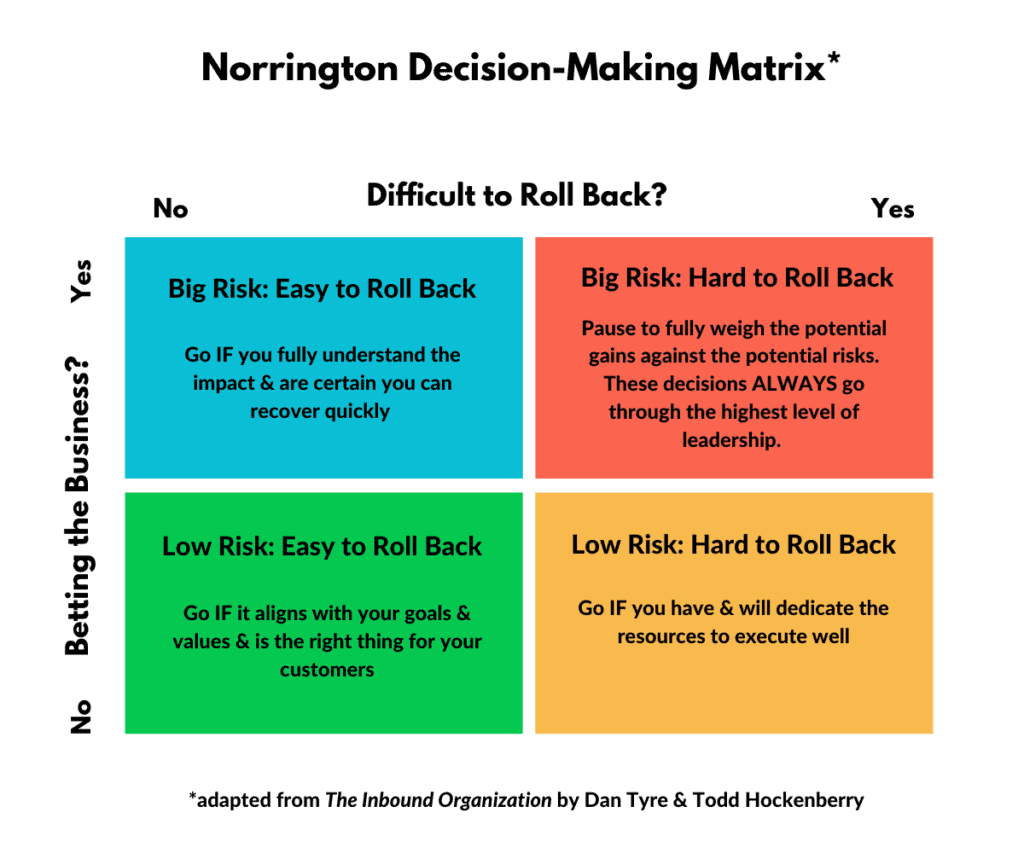Every business decision carries weight. Some choices can propel a company forward, while others can set it back. The challenge is to distinguish between decisions that require careful deliberation and those that can be made swiftly.
Lorrie Norrington, Operating Partner at Lead Edge Capital and a board member at Asana, Eventbrite, Autodesk, Colgate, and HubSpot, knows the importance of decisiveness in business and developed this decision-making framework, which has proven invaluable to these and countless other companies.
When Dan Tyre first introduced me to the framework, I immediately adopted it within my business and frequently share it with our clients. Over the years I’ve found that people are ill-equipped with the skills to make good business decisions and I’m shocked that otherwise brilliant people make decisions that don’t align with their growth goals for their business. There is a better way to make decisions, and this is it.
The Norrington Decision-Making Matrix is a simple yet powerful tool designed to help business leaders categorize decisions based on two critical factors:
- Risk Level – Is this a high-risk or low-risk decision?
- Reversibility – How easy or difficult would it be to roll back this decision?
By plotting decisions within this framework, leaders can make smarter, more strategic choices that align with their goals. Let’s explore how to use the matrix effectively.
Understanding the Matrix
The Norrington Decision-Making Matrix consists of four quadrants:
1. Big Risk: Easy to Roll Back (Top Left – Blue Quadrant)
- These decisions involve significant risks but are relatively easy to reverse.
- Example: Launching a pilot program or a new product test in a limited market.
- Guidance: Proceed if you fully understand the impact and have confidence in your ability to recover quickly should things go awry.
2. Big Risk: Hard to Roll Back (Top Right – Red Quadrant)
- These decisions could significantly impact the business and are difficult to undo.
- Example: Merging with another company or making a major shift in business strategy.
- Guidance: Pause and weigh the potential gains against the risks. These decisions should always go through the highest level of leadership.
3. Low Risk: Easy to Roll Back (Bottom Left – Green Quadrant)
- These decisions are minor, low-stakes, and can be easily reversed.
- Example: Changing a marketing tagline or tweaking a website design.
- Guidance: Move forward if it aligns with your business goals and is beneficial for your customers.
4. Low Risk: Hard to Roll Back (Bottom Right – Yellow Quadrant)
- While low-risk, these decisions are difficult to undo and require dedicated resources.
- Example: Investing in a new software system for company operations.
- Guidance: Only proceed if you have the resources and commitment to execute effectively.
How to Use the Matrix for Better Decision-Making
- Assess the Risk Level – Before making a decision, determine whether it has the potential to impact your business significantly. High-risk decisions should always be approached with greater caution.
- Evaluate Reversibility – Consider how easy or difficult it would be to undo the decision if it doesn’t go as planned. The harder it is to roll back, the more scrutiny it should undergo.
- Follow the Matrix Guidelines – Once categorized, use the recommendations for each quadrant to guide your decision-making process.
- Involve the Right People – Ensure that high-risk and hard-to-reverse decisions involve leadership and key stakeholders for input and approval.
- Be Agile – Use the matrix as a dynamic tool to quickly categorize and adapt to new decisions as they arise.
Why This Matrix Matters
The Norrington Decision-Making Matrix provides a structured approach to making business decisions with clarity and confidence. By distinguishing between high-risk, low-risk, reversible, and irreversible choices, leaders can:
- Reduce decision paralysis
- Avoid costly mistakes
- Improve strategic alignment
- Empower teams to make decisions more efficiently
In a fast-moving business environment, being decisive is key. The Norrington Matrix helps leaders and teams move forward with the right balance of caution and boldness.
Do you have a big decision on your plate? Try mapping it onto the matrix and see how it guides your next move!




